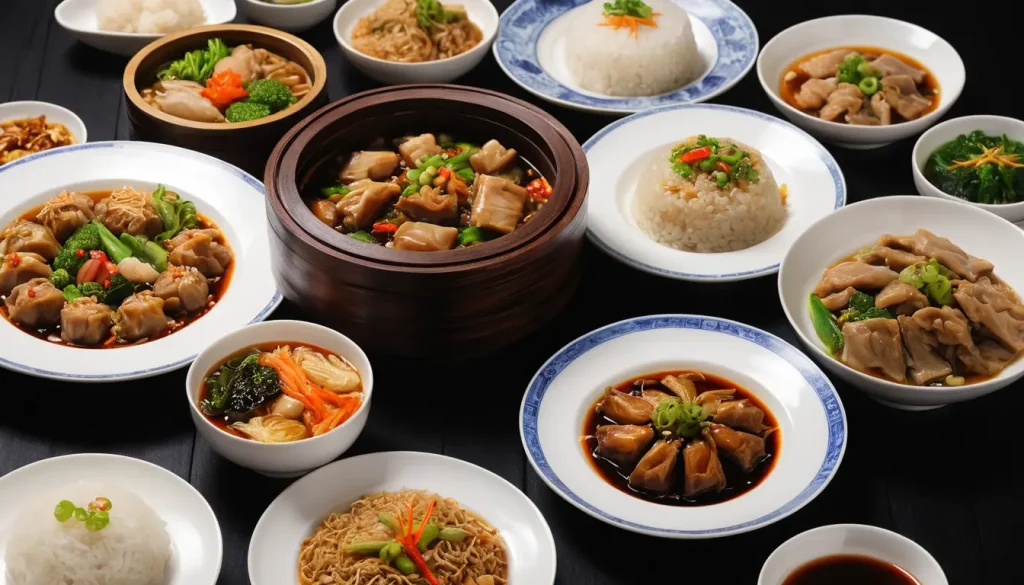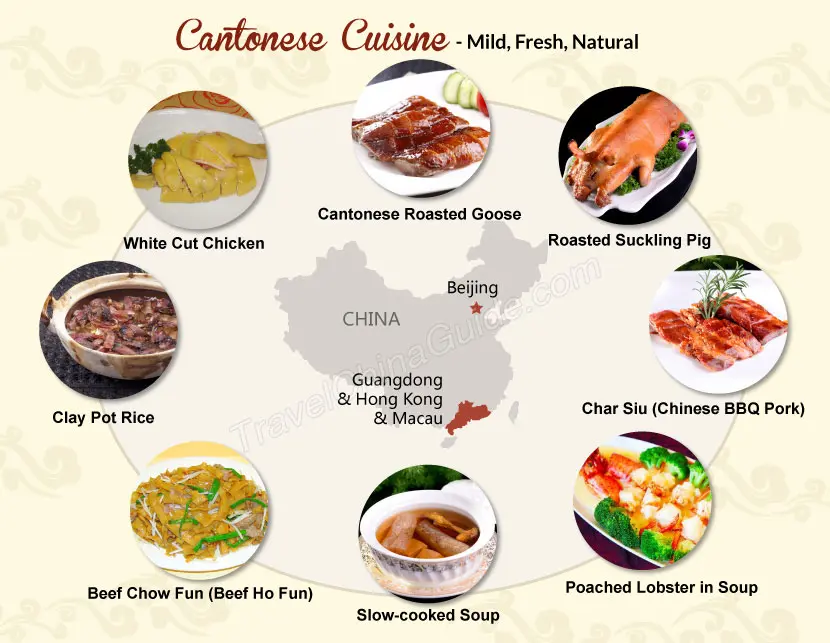Cantonese cuisine, originating from the Guangdong province in southern China, is renowned worldwide for its exquisite flavors, diverse ingredients, and meticulous cooking techniques. With a history spanning centuries, Cantonese cuisine reflects a rich tapestry of cultural influences, seasonal variations, and regional nuances. Let’s delve deeper into the fascinating world of Cantonese gastronomy.

Table of Contents
Historical Background
Origins
Cantonese cuisine traces its roots back to ancient China, evolving over millennia through a blend of indigenous traditions, foreign influences, and geographical advantages. The fertile lands and abundant waterways of Guangdong province provided an abundance of fresh produce, seafood, and poultry, shaping the culinary landscape of the region.
Influences
Throughout its history, Cantonese cuisine has been influenced by various factors, including trade routes, migration patterns, and imperial preferences. The region’s proximity to the Pearl River Delta facilitated cultural exchanges with neighboring provinces, as well as foreign traders from Southeast Asia, Europe, and beyond.
Key Ingredients in Cantonese Cuisine
Seafood
Given its coastal location, seafood plays a prominent role in Cantonese cooking. Fresh fish, shrimp, crab, and shellfish are often showcased in steamed, stir-fried, or braised dishes, highlighting their natural flavors and textures.
Vegetables
Cantonese cuisine emphasizes the use of seasonal vegetables, such as bok choy, Chinese broccoli, and snow peas. These ingredients are stir-fried, blanched, or braised to preserve their crispness and vibrant colors, complementing meat and seafood dishes.
Sauces
A variety of sauces and condiments are essential for enhancing the flavors of Cantonese cuisine. From savory oyster sauce to tangy hoisin sauce, each condiment adds depth and complexity to dishes, balancing sweet, salty, sour, and umami notes.
Cooking Techniques
Stir-frying
Stir-frying is a quintessential Cantonese cooking technique, characterized by high heat, quick cooking times, and constant stirring. This method preserves the natural flavors and textures of ingredients while imparting a smoky wok hei aroma.
Steaming
Steaming is another prevalent cooking method in Cantonese cuisine, especially for delicate seafood and dim sum. By gently cooking ingredients over boiling water, steaming retains their moisture and nutrients, resulting in tender and succulent dishes.
Roasting
Roasting, particularly of meats like duck and pork, is a cherished tradition in Cantonese cuisine. The use of marinades, glazes, and specialized ovens creates crispy skin, tender meat, and complex flavors, making roast meats a popular choice for festive occasions.
Popular Cantonese Dishes
Dim Sum
Dim sum, meaning “touch the heart” in Cantonese, refers to a diverse range of bite-sized dishes served with tea. From steamed dumplings and buns to crispy spring rolls and custard tarts, dim sum offers a delightful array of flavors and textures, perfect for communal dining.
Roast Duck
Cantonese-style roast duck is prized for its succulent meat, crispy skin, and aromatic spices. Marinated in a blend of soy sauce, ginger, and five-spice powder, the duck is roasted until golden brown, resulting in a mouthwatering dish that epitomizes Cantonese culinary mastery.
Sweet and Sour Pork
Sweet and sour pork is a beloved Cantonese dish that balances tangy pineapple and bell peppers with tender chunks of pork, coated in a crispy batter and smothered in a vibrant sweet and sour sauce. This iconic dish exemplifies the harmony of flavors and textures in Cantonese cooking.
Regional Variations
Hong Kong Style
Hong Kong-style Cantonese cuisine is characterized by its cosmopolitan flair, innovative culinary techniques, and luxury ingredients. Influenced by British colonial rule and international trade, Hong Kong cuisine features refined dim sum, seafood delicacies, and upscale dining experiences.
Guangzhou Style
Guangzhou, the capital of Guangdong province, is renowned for its traditional Cantonese cuisine, focusing on fresh ingredients, subtle flavors, and time-honored recipes. From classic dim sum to herbal soups and slow-cooked stews, Guangzhou-style cooking emphasizes simplicity and authenticity.
Chaozhou Style
Chaozhou cuisine, originating from the eastern region of Guangdong province, is known for its light, delicate flavors and emphasis on seafood and vegetables. Steaming and braising are prevalent cooking methods, allowing the natural essence of ingredients to shine through in each dish.
Cultural Significance
Festivals and Celebrations
Cantonese cuisine plays a central role in traditional festivals and celebrations, where families gather to share elaborate meals and exchange blessings. From Lunar New Year feasts to wedding banquets and ancestral rites, food symbolizes prosperity, happiness, and familial ties in Cantonese culture.
Family Gatherings
Family gatherings, known as “yum cha” in Cantonese, are a cherished tradition where relatives come together to enjoy dim sum, tea, and lively conversation. These communal meals foster bonds between generations and reinforce cultural values of filial piety and respect for elders.
Health Benefits
Balanced Nutrition
Cantonese cuisine emphasizes a balanced approach to nutrition, incorporating a variety of vegetables, lean proteins, and grains into meals. By focusing on fresh, seasonal ingredients and minimizing the use of oils and fats, Cantonese cooking promotes overall health and well-being.
Low Fat Content
Unlike some other Chinese cuisines that use heavy sauces and deep-frying techniques, Cantonese cuisine tends to be lighter and lower in fat. By stir-frying, steaming, and poaching ingredients, Cantonese chefs create flavorful dishes without excessive calories or cholesterol.
Fresh Ingredients
The use of fresh, locally sourced ingredients is a cornerstone of Cantonese cuisine, ensuring optimal flavor, texture, and nutritional value. From live seafood and crisp vegetables to fragrant herbs and aromatic spices, the quality of ingredients is paramount in Cantonese cooking.
Global Influence and Popularity
Cantonese cuisine has enjoyed widespread popularity and influence beyond China’s borders, thanks to the global diaspora of Cantonese immigrants and the proliferation of Chinese restaurants worldwide. From bustling Chinatowns to upscale dining establishments, Cantonese cuisine continues to captivate diners with its diverse flavors and culinary craftsmanship.
Authentic Cantonese Restaurants
Tips for Dining
When dining at authentic Cantonese restaurants, consider the following tips to enhance your culinary experience:
- Ask for Recommendations: Seek guidance from staff or regular patrons for must-try dishes and chef specialties.
- Explore Dim Sum: Venture beyond familiar favorites and sample a variety of dim sum dishes for a true taste of Cantonese cuisine.
- Enjoy Seasonal Specialties: Embrace seasonal ingredients and regional specialties to savor the freshest flavors of Cantonese cooking.
Must-Try Dishes
- Cantonese Barbecue: Indulge in succulent roast meats, including char siu (barbecue pork) and siu yuk (crispy roast pork belly).
- Clay Pot Delights: Try classic clay pot dishes like braised chicken with mushrooms or seafood medley with tofu for hearty, comforting meals.
- Fresh Seafood: Explore the seafood offerings, such as steamed fish with ginger and scallions or wok-tossed crab with black bean sauce, for a taste of coastal Cantonese cuisine.
Fusion Cuisine
Cantonese-Western Fusion
In recent years, Cantonese cuisine has undergone a creative renaissance, inspiring chefs to experiment with fusion flavors and innovative techniques. From lobster with cheese and truffle-infused dim sum to foie gras-stuffed dumplings and matcha custard buns, Cantonese-Western fusion cuisine pushes culinary boundaries while honoring tradition.
Modern Interpretations
Contemporary chefs are reimagining Cantonese classics with a modern twist, incorporating global ingredients and culinary trends into traditional recipes. Whether it’s a deconstructed egg tart or a vegan-friendly take on sweet and sour pork, these inventive dishes reflect the evolving tastes and preferences of today’s diners.
DIY Cantonese Cooking
Basic Recipes
For home cooks eager to recreate Cantonese flavors in their own kitchens, here are some essential recipes to try:
- Egg Fried Rice: Master the art of wok-tossed fried rice with eggs, vegetables, and a dash of soy sauce for a quick and satisfying meal.
- Steamed Dumplings: Learn how to make delicate dumpling wrappers filled with savory pork, shrimp, or vegetables, steamed to perfection and served with dipping sauce.
Ingredients Substitutions
If you’re unable to find certain Cantonese ingredients at your local grocery store, consider these substitutions:
- Oyster Sauce: Substitute hoisin sauce or a combination of soy sauce and sugar for a similar sweet and savory flavor profile.
- Chinese Rice Wine: Use dry sherry or mirin as a substitute for Chinese rice wine in marinades and sauces.
Sustainability in Cantonese Cuisine
Responsible Sourcing
As awareness of environmental issues grows, many Cantonese restaurants are prioritizing sustainable sourcing practices, such as sourcing seafood from certified fisheries and supporting local farmers and producers.
Reduction of Food Waste
Cantonese cuisine emphasizes resourcefulness and frugality in the kitchen, with leftover ingredients often repurposed into new dishes or used to make flavorful broths and stocks. By minimizing food waste, Cantonese chefs strive to create delicious meals while respecting the environment.
Challenges and Controversies
Authenticity Concerns
As Cantonese cuisine gains popularity worldwide, there is ongoing debate and concern over the authenticity of dishes served outside of China. Some adaptations may stray from traditional recipes or use inferior ingredients, diluting the essence of Cantonese cooking.
Modernization vs. Tradition
The rapid pace of urbanization and globalization poses challenges to traditional Cantonese culinary practices, as younger generations gravitate towards fast food and Westernized diets. Preserving cultural heritage and culinary traditions while embracing innovation remains a delicate balance for Cantonese chefs and food enthusiasts alike.
Conclusion
In conclusion, Cantonese cuisine stands as a testament to the rich culinary heritage and ingenuity of the Guangdong province in southern China. With its emphasis on fresh ingredients, balanced flavors, and meticulous preparation, Cantonese cuisine continues to captivate diners around the world, offering a tantalizing journey through the vibrant flavors of southern China.
Unique FAQs
- What sets Cantonese cuisine apart from other Chinese regional cuisines? Cantonese cuisine is known for its emphasis on fresh ingredients, subtle flavors, and delicate cooking techniques, setting it apart from the bold flavors and fiery spices of Sichuan or Hunan cuisine.
- Are there any vegetarian options in Cantonese cuisine? Yes, Cantonese cuisine offers a variety of vegetarian dishes, including stir-fried vegetables, tofu-based dishes, and meatless dim sum options like vegetable dumplings and spring rolls.
- What are some popular Cantonese desserts? Popular Cantonese desserts include mango pudding, egg custard tarts, sesame balls filled with sweet red bean paste, and glutinous rice dumplings served in sweet soup.
- Is Cantonese cuisine suitable for people with dietary restrictions? Yes, Cantonese cuisine can accommodate various dietary restrictions, with options for gluten-free, vegetarian, and low-fat dishes available at many Cantonese restaurants.
- Where can I find authentic Cantonese cuisine outside of China? Authentic Cantonese cuisine can be found in major cities with large Chinese immigrant populations, such as New York, San Francisco, Vancouver, and Sydney, as well as in renowned Chinatowns around the world.

